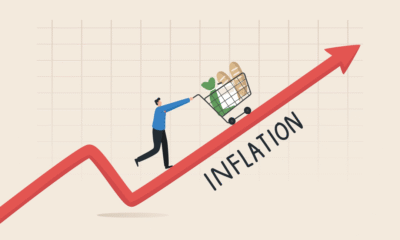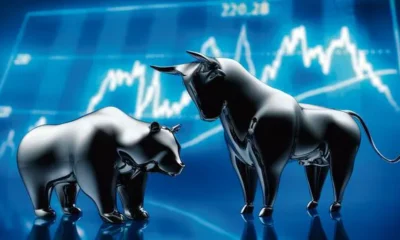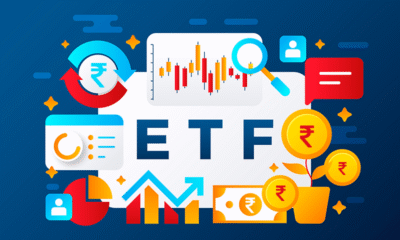Finance
USA Market Trends & Global Finance Insights

Introduction to the Current Economic Climate
As we examine the financial landscape in 2023, the U.S. economy presents a complex but compelling picture shaped by various indicators and trends. One of the primary components of this economic overview is the Gross Domestic Product (GDP) growth rate, which offers insight into the economic expansion or contraction over time. Currently, the USA market is experiencing moderate growth, reflecting a delicate balance between consumer spending, business investment, and external economic forces that influence trade. This moderate pace poses both opportunities and challenges for stakeholders looking to navigate their financial strategies within this context.
Another critical indicator to consider is the unemployment rate. As of 2023, the labor market has shown resilience, with unemployment rates hovering at relatively low levels. This stability lends support to consumer confidence, which plays a significant role in driving economic activity. However, underlying issues such as labor shortages in certain sectors and wage inflation continue to present challenges that could impact future employment dynamics and, ultimately, the overall financial health of the USA market.
Furthermore, the persistent trends related to inflation cannot be overlooked. Inflation rates, which have fluctuated notably over the past few years, remain a focal point for policymakers and economists alike. The Federal Reserve’s responses to these inflationary pressures have significant implications for interest rates, consumer purchasing power, and investment decisions across the globe. As global finance news outlines various economic strategies employed by governments in response to similar inflation challenges, it is essential to critically assess the potential outcomes and ripple effects in both the USA market and the worldwide economic arena.
In light of these key indicators, the current economic climate serves as a crucial backdrop for analyzing broader financial trends and implications on both domestic and international fronts.
Key Trends in the USA Market
The U.S. financial markets in 2023 are experiencing notable shifts shaped by consumer behavior, evolving economic conditions, and significant government policies. These trends are critical for investors and stakeholders seeking to navigate the complexities of the evolving finance landscape. A key observation is the shift in consumer spending patterns. Post-pandemic recovery has led to increased discretionary spending, particularly in sectors such as technology, travel, and healthcare. As consumers prioritize experiences and services, businesses have adapted to cater to this demand, which can be observed through improved earnings reports from various sectors.
Additionally, stock market performance has seen notable fluctuations, primarily driven by interest rate adjustments and inflation concerns. The Federal Reserve’s monetary policy in response to inflation is heavily influencing the investment climate. Tech stocks, previously deemed volatile, have shown resilience as companies innovate and pivot towards sustainable practices. Furthermore, the rise of artificial intelligence and digital finance is transforming traditional business models, propelling companies in these sectors to the forefront of market growth.
Alongside these consumer dynamics, specific industry sectors are emerging as primary growth engines. Renewable energy, for instance, has gained traction thanks to government incentives and heightened environmental awareness. Investment in clean technologies and electric vehicles reflects the government’s commitment to climate goals and has garnered substantial capital, fueling advancements and job creation within this burgeoning sector.
The intersection of government policies and market dynamics cannot be overlooked. New legislation impacting trade, taxation, and infrastructure investment plays a pivotal role in shaping investor sentiment and strategic decision-making. As the landscape of global finance evolves, tracking these trends within the USA market remains vital for stakeholders looking to capitalize on emerging opportunities.
Impact of Global Events on U.S. Finance
The United States financial landscape is profoundly influenced by global political and economic events. As one of the largest economies in the world, fluctuations in international markets significantly impact the USA market. International trade agreements, for instance, can alter the competitive dynamics for U.S. industries. Favorable trade agreements may enhance profitability and expand market access for American businesses, while restrictive tariffs or sanctions can limit growth prospects and elevate operational costs. Consequently, understanding the implications of these agreements is essential for investors and policymakers alike.
Additionally, geopolitical tensions create an environment of uncertainty that often results in market volatility. When conflicts arise or diplomatic relations strain, financial markets typically react. Investors may become hesitant, leading to a decline in stock prices and increased demand for safe-haven assets such as gold or government bonds. The USA market, as a pivotal player in global finance, must navigate these instances carefully, utilizing strategic investment approaches that account for risk management and capital preservation.
The impact of global health crises, such as pandemics, further underlines the interconnectedness of finance worldwide. The recent COVID-19 pandemic serves as a poignant example, demonstrating how health emergencies can disrupt supply chains, halt economic activity, and drastically shift consumer behaviors. U.S. financial markets witnessed steep downturns during the onset of the pandemic, prompting rapid responses from the Federal Reserve to stabilize the economy. Such global events compel investors to reevaluate their strategies, placing a heightened emphasis on resilience and adaptability in their financial planning.
In conclusion, the intricate relationship between global events and U.S. finance underscores the necessity for stakeholders to maintain awareness of world news and its potential implications on investment strategies. A holistic understanding of international dynamics enables better decision-making and risk mitigation in the ever-evolving financial landscape.
Emerging Markets and Investment Opportunities
The concept of emerging markets has gained significant traction among U.S. investors looking to diversify their portfolios and capitalize on growth opportunities outside of the domestic landscape. Emerging markets, often characterized by rapid industrialization and rising income levels, present unique investment potential within various sectors, making them a focal point for investors aiming to optimize their returns. Specifically, regions such as Southeast Asia, Sub-Saharan Africa, and Latin America have witnessed substantial economic development, showcasing sectors ripe for investment, including technology, infrastructure, and consumer goods.
Technology, in particular, has played a pivotal role in transforming emerging markets. Countries like India and Brazil are experiencing a digital boom, with burgeoning tech startups attracting foreign direct investments from the USA market. Investments in fintech and e-commerce are notable examples of how technology is reshaping these economies, allowing investors to tap into diverse and innovative business models that cater to growing consumer demands. As connectivity improves and digital literacy expands, U.S. investors are increasingly focusing on these sectors to capitalize on their growth trajectories.
However, despite their attractive prospects, investing in emerging markets comes with its set of risks. Economic instability, political turbulence, and regulatory challenges can impede investment returns and affect market confidence. Therefore, thorough due diligence and regional analysis are essential for U.S. investors as they navigate these landscapes. Furthermore, while the potential for high returns is enticing, it is crucial for investors to balance their risk exposure with diversified strategies to mitigate the effects of market volatility. Adapting to the dynamics of global finance through informed investment strategies will enable investors to capitalize on the emerging markets in a prudent manner.
Regulatory Changes and Their Implications
The finance sector operates within a constantly evolving regulatory landscape, which is crucial for maintaining system stability and protecting consumer interests. Recent shifts in fiscal policies and the introduction of new financial regulations greatly influence the dynamics of both the USA market and the global finance environment. Understanding these changes is essential for institutions, consumers, and investors alike.
In the United States, regulatory bodies have actively sought to address emerging challenges and opportunities within the finance sector. For instance, the introduction of new compliance obligations has required financial institutions to enhance their risk management frameworks and investment strategies. These adaptations ensure that institutions remain compliant while also safeguarding consumers’ financial assets. Furthermore, recent changes aimed at enhancing transparency in financial reporting have significant implications for investor decision-making processes in the USA market.
On a global scale, harmonizing financial regulations across countries has become a priority, particularly in light of expanding trade agreements and cross-border investments. Regulatory authorities are increasingly collaborating to streamline compliance requirements, addressing concerns that span international markets. Such efforts aim to mitigate financial risks while promoting growth and stability. This cooperation is especially relevant as financial assets and investment opportunities are no longer confined to local markets, leading to a more interconnected finance ecosystem.
Moreover, regulatory changes can create both opportunities and challenges for investors. New rules may open doors for emerging sectors, such as fintech and green finance, offering innovative investment avenues. Conversely, tightening regulations may lead to a recalibration of existing investment strategies. As the finance sector adapts to these shifts, professionals and consumers must remain vigilant, ensuring they stay informed and resilient in the face of ongoing regulatory transformations.
Technological Advances: FinTech and Beyond
The financial landscape has witnessed significant transformation over the past decade, primarily driven by technological advances. Among these, the rise of FinTech companies has been paramount in reshaping how financial services are delivered and consumed. FinTech, short for financial technology, encompasses a wide range of innovations such as mobile banking, peer-to-peer lending, robo-advisors, and payment processing solutions. These advancements provide users with enhanced access and convenience, effectively democratizing financial services across diverse demographics within the USA market and beyond.
Moreover, innovations in digital currency, particularly with the emergence of cryptocurrencies like Bitcoin and Ethereum, have played a crucial role in the evolving finance environment. These digital assets, based on blockchain technology, offer individuals an alternative to traditional banking systems and have introduced new investment opportunities. The incorporation of blockchain facilitates secure, transparent transactions, thereby reducing fraud and enhancing trust in online finance dealings. This disruptive technology is integral to the ongoing transformation in both personal finance and market transactions.
Artificial intelligence (AI) is another technology making profound inroads in the finance sector. AI algorithms can analyze vast volumes of data to identify patterns and make predictions, leading to more informed investment strategies. Financial institutions leverage AI for risk assessment, customer service via chatbots, and automating trading processes, thereby optimizing their operations and reducing costs. Online trading platforms have further revolutionized how individuals engage with the financial markets, enabling them to execute trades in real-time and access a wealth of financial information at their fingertips. These platforms cater to both novice and experienced investors, fostering a more inclusive investment environment.
Debt and Market Stability: A Closer Look
The interplay between national debt, corporate debt levels, and market stability is critical in understanding the financial landscape of the USA market. In recent years, increasing levels of both public and private debt have raised concerns about the long-term implications for economic health. Nationally, the growing federal debt—exacerbated by substantial government spending—has become a focal point for policymakers. As of October 2023, the USA’s national debt stands at an alarming figure, prompting discussions regarding fiscal responsibility and the ability to manage this burden without triggering economic instability.
On the corporate front, mounting debt levels reflect the aggressive strategies companies have adopted to finance expansion and maintain operations in a competitive environment. High corporate leverage can lead to vulnerability, especially during economic downturns. As businesses service their debts, the cost associated with interest rates becomes a pivotal factor that influences their financial health. The Federal Reserve’s shifting monetary policy and the resulting interest rates directly affect borrowing costs for corporations, weighing heavily on their balance sheets. A spike in interest rates may lead to higher debt servicing costs, potentially impacting profitability and stalling investments.
Inflation serves as another critical variable in this equation. Rising inflation rates can erode purchasing power and increase operational costs for businesses, compounding the strain of existing debt. In an environment with high inflation, interest rates are often adjusted, leading to a cascade of economic effects, including reduced consumer spending and slower growth. Understanding the relationship between these factors—especially how they relate to market stability—requires close observation of both global finance news and domestic economic indicators.
As we analyze the current financial health of the USA market, it’s essential to consider the implications of both national and corporate debt levels. With the potential for rising interest rates and persistent inflation, the challenges facing businesses and the government underscore the need for a comprehensive approach to debt management and fiscal policies. Only through informed strategies can we hope to maintain stability in an increasingly complex financial landscape.
The Future of Investing: Predictions and Strategies
As the financial landscape evolves, investors are compelled to reassess their strategies in light of both the USA market and broader world news. Predictions for the future of investing indicate a shift towards digital assets, sustainable investments, and technological innovations. Analysts highlight that with the increasing relevance of cryptocurrency and blockchain technology, traditional investment approaches may require adaptation. Individuals and institutions alike might benefit from integrating digital currencies into their portfolios to maximize potential returns while addressing emerging risks.
Furthermore, the current trends in climate awareness have spurred interest in Environmental, Social, and Governance (ESG) investing. Investors are now more inclined to consider how companies align with sustainable practices, resulting in a shift towards green technologies and renewable energy sources. Institutions that adopt ESG criteria in their investment strategies not only enhance their social responsibility but also better position themselves to benefit from evolving regulatory frameworks and consumer preferences.
Risk management remains a fundamental tenet in crafting an effective investment strategy. With global uncertainties, including geopolitical tensions and inflationary pressures, diversifying investment portfolios becomes crucial. Investors should explore a mix of asset classes, including equities, bonds, real estate, and commodities, to hedge against potential market volatility. This diversification approach can potentially enhance returns while mitigating risks associated with overexposure to a single asset type.
In the context of a transforming financial environment, long-term planning is paramount. Investors are encouraged to remain informed about market dynamics, economic indicators, and geopolitical factors that influence the USA market. A clear understanding of these elements can aid in making informed decisions that align with personal financial goals. By staying adaptable and receptive to change, investors can navigate uncertainties and capitalize on forthcoming opportunities, ensuring a robust foundation for future financial success.
Conclusion: Preparing for What Lies Ahead
In navigating the intricate landscape of finance, understanding the dynamics of the USA market and the broader context of world news becomes paramount. This blog post has traversed significant themes impacting financial decision-making and has underscored how global events can ripple through local markets. From fluctuations in currency to volatile stock trends, the financial ecosystem is influenced by a myriad of factors that are often interconnected. Thus, staying attuned to both national and international developments is essential for any investor or financial enthusiast.
As the USA market continues to evolve, it is crucial for individuals to adopt adaptable investment strategies that reflect current economic realities. The insights shared throughout this discussion highlight the necessity for investors to remain vigilant and informed. Engaging with financial news platforms, analysis reports, and expert opinions can provide valuable context that informs sound investment choices. Furthermore, it is advisable for investors to periodically assess their portfolios to ensure alignment with shifting market conditions and emerging opportunities.
The conclusion derived from our exploration reinforces a proactive approach to finance. Whether one is a seasoned investor or a newcomer, the importance of informed decision-making cannot be overstated. Global finance news is rich with information that can signal rising trends or potential downturns. Therefore, leveraging this information wisely will enhance one’s capacity to navigate uncertainties. As we look towards the future, remaining equipped with knowledge and adaptability will serve as the bedrock for making prudent financial decisions in an increasingly complex world.
Investing
Global Investor Outflows from U.S. Stocks & Dollar

In a shift that is sending ripples across financial markets, institutional investors around the world are pulling back from U.S. equities and reducing exposure to the U.S. dollar, signaling a significant change in sentiment toward American assets. According to the latest Bank of America Global Fund Manager Survey, global investors are now the most underweight on U.S. stocks in more than two decades, with the dollar facing similar skepticism as a long-term safe-haven asset. This transition is being fueled by multiple converging factors, including geopolitical instability, growing U.S. fiscal deficits, trade tensions, and an increasingly favorable investment climate in Europe and select emerging markets. For investors, economists, and policymakers alike, this trend represents a rebalancing of global capital flows that could reshape market dynamics in the months ahead.
Investor Sentiment Toward U.S. Markets Hits Multi-Year Lows
The Bank of America survey, considered a key barometer of global institutional sentiment, reveals that fund managers have turned heavily underweight on U.S. stocks and the dollar, preferring instead to rotate their portfolios into European and Asian equities. The survey showed that 36% of participants are now net underweight U.S. equities—the highest level since 2003. At the same time, positioning on the dollar turned net negative for the first time in over five years, with investors citing mounting fiscal concerns, valuation extremes, and weakening macroeconomic indicators.
The U.S. equity market, especially the tech-heavy NASDAQ, has experienced an extraordinary bull run over the last several years. But now, investors are questioning the sustainability of elevated valuations, particularly as economic growth slows, earnings forecasts are revised downward, and inflation remains persistently above target. Many portfolio managers believe the best returns may no longer be found in U.S. assets alone.
Rising U.S. Debt and Fiscal Deficits Raise Red Flags
A key driver of investor caution is the ballooning U.S. fiscal deficit. The Congressional Budget Office (CBO) projects that the U.S. federal deficit will reach over $1.8 trillion this year, driven by increased government spending, rising interest costs, and lower-than-expected tax revenues. The national debt is now projected to exceed 125% of GDP by 2030, raising serious questions about long-term fiscal sustainability.
Investors fear that soaring U.S. debt levels could lead to a loss of confidence in Treasury securities, pushing yields higher and triggering volatility in global credit markets. This concern is magnified by the growing political polarization in Washington, which has led to repeated debt ceiling standoffs and policy gridlock. As a result, some asset managers are choosing to diversify their bond portfolios with sovereign debt from countries like Germany, Canada, and Australia—nations viewed as having stronger fiscal discipline.
Geopolitical Tensions Erode Dollar Safe-Haven Appeal
The traditional role of the U.S. dollar as a global safe-haven currency is also being called into question. With the U.S. now embroiled in rising geopolitical conflicts, including its military engagement in the Middle East and an escalating trade war with China, the perception of the dollar as a “neutral” or stable currency is beginning to fade. Several countries, particularly in the Global South, have voiced frustration over the dominance of the dollar in international trade, and some have even accelerated efforts to settle trade in alternative currencies such as the euro, yuan, or local currency blocs.
In response, central banks in emerging markets are reducing their U.S. dollar reserves and increasing holdings in gold and non-dollar currencies. This trend, while gradual, is gaining momentum and contributing to the dollar’s underperformance against a basket of global currencies. The U.S. dollar index (DXY) has declined by nearly 6% year-to-date, reflecting both diminished investor confidence and a broader reconfiguration of reserve management strategies.
Attractive Valuations Abroad Drive Capital Outflows
While risks in the U.S. are mounting, attractive investment opportunities abroad are also contributing to the outflow of capital from American markets. European equities, particularly in sectors like green energy, luxury goods, and financial services, are seeing renewed interest thanks to relatively low valuations and improving macroeconomic stability. The recent ECB rate cuts and Eurobond discussions have added to optimism about the region’s fiscal and financial integration.
In Asia, countries like India, Indonesia, and Vietnam are emerging as new hotspots for foreign direct investment and equity inflows. These economies offer robust growth prospects, younger demographics, and increasingly tech-driven industries. Additionally, Japan’s bond market is seeing increased institutional buying, as long-term yields rise in response to the Bank of Japan’s policy changes.
This global diversification strategy is not just about seeking higher returns—it’s also about managing risk. Investors are increasingly looking to balance their portfolios geographically, reducing dependence on any single region and hedging against macroeconomic shocks that may be specific to the U.S.
Currency Hedging and Diversification as Defensive Strategies
In response to the dollar’s volatility, many fund managers are now engaging in currency hedging strategies to protect their portfolios. Currency ETFs, options, and forward contracts are being used to minimize the downside risk of a weakening dollar. At the same time, global investment funds are ramping up their exposure to non-dollar-denominated assets, including eurozone corporate bonds, emerging market debt, and local-currency sovereign issues.
Moreover, ESG and green bond markets in Europe and Asia are attracting capital due to their alignment with global sustainability goals. These instruments not only offer diversification but also align with broader institutional mandates on responsible investing.
Implications for U.S. Markets and Monetary Policy
The capital flight from U.S. assets could have significant implications for American markets. A persistent decline in foreign demand for U.S. Treasuries may force the Federal Reserve to intervene more frequently in the bond market to maintain liquidity and control yields. At the same time, a weaker dollar could contribute to imported inflation, complicating the Fed’s efforts to bring core inflation back within its target range.
On the equities side, if investor outflows persist, U.S. companies may face higher capital costs and declining valuations, particularly in sectors that rely heavily on foreign investment or exports. Domestic pension funds and institutional investors may need to fill the gap left by global investors, which could further alter asset allocation strategies and influence corporate financing decisions.
A New Era of Global Capital Rotation
The growing shift away from U.S. stocks and the dollar signals the beginning of a new era in global investing, one defined by diversification, geopolitical hedging, and currency rebalancing. While the U.S. remains a central player in global finance, the days of unquestioned dominance are beginning to fade, as investors embrace a more nuanced and distributed view of risk and opportunity.
For market participants, staying agile in this environment means tracking global fund flows, monitoring geopolitical developments, and reassessing the traditional U.S.-centric portfolio model. As capital continues to flow into European and Asian markets, the future of global finance is being rewritten—and those who adapt early may find themselves ahead of the curve.
Finance and Economy
France Pushes Eurozone Toward Joint Eurobond Issuance

In a bold move that could redefine the financial architecture of the European Union, France has renewed its push for the issuance of joint eurozone debt instruments – commonly referred to as Eurobonds – as a way to strengthen the euro on the global stage. As the EU prepares for its upcoming summit on June 26-27, the proposal is once again stirring heated debate among member nations. French officials argue that a shared debt mechanism is essential not only for financial resilience but also for elevating the euro’s standing as a credible alternative to the U.S. dollar. While the idea garners support from key institutions like the IMF and the ECB, resistance from fiscally conservative member states continues to block consensus. This article explores the implications of France’s proposal, the potential benefits and challenges of Eurobond issuance, and the evolving role of the euro in a multipolar financial world.
France’s Strategic Case for Eurobonds
French President Emmanuel Macron and Finance Minister Bruno Le Maire have long been advocates for deeper EU financial integration. According to them, Eurobonds would represent a tangible step toward fiscal solidarity and monetary cohesion, allowing member nations to borrow at collectively favorable rates while demonstrating political unity. The latest push comes at a time when the European economy is facing several headwinds: slowing growth, fragmented recovery across member states, and heightened global financial volatility triggered by geopolitical conflicts and energy insecurity. Macron has reiterated that a common debt tool is essential for financing major EU-wide projects such as green energy transition, digital infrastructure, and military defense.
From a strategic standpoint, France views Eurobonds as more than just a financial mechanism – they are a symbol of EU credibility and resilience. By pooling risk and aligning borrowing capacity, the eurozone could present a united front in capital markets, reducing the vulnerability of weaker economies and improving the euro’s attractiveness to foreign investors.
The Euro’s Current Global Standing and Its Challenges
Despite being the world’s second most-used currency, the euro still lags far behind the U.S. dollar in terms of global reserve share, trade settlement, and safe-haven preference. Analysts point out that one of the primary reasons for this is the fragmented nature of the eurozone bond market. Each country issues its own sovereign debt, leading to a lack of a single, risk-free eurozone bond benchmark – unlike U.S. Treasuries, which offer deep liquidity and low risk.
France’s proposal seeks to address this imbalance. A unified Eurobond market could create a highly liquid, stable, and scalable financial product that would attract central banks, pension funds, and sovereign wealth investors. Over time, this could shift more global reserves into euros, boosting the currency’s influence in global trade and finance.
Institutional Support: IMF, ECB, and Market Participants
Key international organizations have thrown their weight behind the idea. The International Monetary Fund (IMF) has suggested that Eurobonds could enhance the EU’s fiscal capacity and crisis response agility. Meanwhile, European Central Bank (ECB) officials, including President Christine Lagarde, have hinted that deeper fiscal integration is necessary for the euro to realize its full potential.
Financial market participants have also shown interest. Asset managers argue that Eurobonds could become a cornerstone of fixed-income portfolios, particularly for investors looking to diversify away from dollar-denominated assets. Some analysts compare the opportunity to the creation of the U.S. Treasury market in the post-war era, which laid the groundwork for the dollar’s global dominance.
Opposition from the Frugal Four and Risk-Sharing Concerns
Despite France’s enthusiasm and institutional support, significant opposition persists from fiscally conservative EU nations, notably Germany, Austria, the Netherlands, and Finland—often dubbed the “Frugal Four.” These countries argue that shared debt would penalize responsible fiscal behavior and open the door to moral hazard, where weaker economies might overborrow under the protection of joint guarantees.
German officials have also cited constitutional constraints and public opposition to any perceived “debt mutualization.” Instead, they advocate for reforms at the national level, more stringent budget controls, and the use of existing mechanisms like the European Stability Mechanism (ESM) for crisis funding.
This divide continues to stall formal negotiations. At the heart of the debate is the question of trust and fiscal governance, as many northern states remain skeptical about the long-term commitment of their southern counterparts to austerity and budget discipline.
Implications for Financial Markets and Investors
If approved, Eurobonds would be a game-changer for European capital markets. They would offer a new safe asset class, potentially rivaling U.S. Treasuries in size and reliability over the long term. For the European banking system, Eurobonds could provide high-quality collateral and improve liquidity conditions, especially for cross-border lending.
Investors are closely monitoring the situation. If the EU takes concrete steps toward joint bond issuance, bond yields across peripheral economies like Italy, Spain, and Greece could compress further, as risk premia shrink in anticipation of shared guarantees. Simultaneously, euro-denominated assets may see a surge in foreign inflows, especially from central banks seeking to rebalance reserve portfolios.
Strengthening the Euro’s Role in a Multipolar World
The geopolitical landscape is increasingly defined by multipolarity, with China, Russia, and the U.S. competing for influence in trade, finance, and security. In this context, the eurozone faces a historic opportunity to carve out a more assertive role. Strengthening the euro through fiscal and capital market integration is seen as essential to counterbalance the dollar’s dominance and reduce reliance on U.S.-led financial infrastructure.
Eurobonds could serve as a financial pillar in this transition. As global investors seek alternatives in a fragmented world economy, the euro’s rise as a stable, investable, and liquid currency backed by joint instruments could bolster its credibility and utility.
A Defining Moment for European Unity
France’s push for Eurobonds is more than just a fiscal proposal – it is a call for political and financial unity in a time of global uncertainty. While the road to consensus is steep, the growing support from institutions, investors, and southern EU members suggests that momentum is building. The upcoming EU summit will be a crucial test of the bloc’s ability to move beyond national interests and toward a shared financial future.
If successful, Eurobond issuance could redefine the eurozone’s role in the global economy, offering new tools for crisis response, economic development, and financial competitiveness. For investors and policymakers alike, this moment marks a critical juncture – either Europe seizes the opportunity to lead, or it risks remaining a secondary player in a rapidly evolving financial world.
Finance and Economy
Oil Price Spike as Middle East Conflict Deepens: A Global Market Wake-Up Call

The financial world is once again on high alert as escalating tensions in the Middle East have triggered a sharp surge in global oil prices, sending shockwaves through equity, commodity, and currency markets alike. With the U.S. reportedly striking Iran’s nuclear sites, Brent crude surged over 18%, nearing $80 per barrel in a matter of hours. The sudden volatility reignited fears of a potential $100 oil scenario, reminiscent of past geopolitical flashpoints that deeply impacted global supply chains, inflation expectations, and central bank policy stances. This article delves into the causes, consequences, and global financial implications of this emerging crisis.
The Trigger: U.S. Strikes on Iran’s Nuclear Infrastructure
On June 21, 2025, international news outlets confirmed that U.S. military forces had targeted Iranian nuclear facilities in what they described as a “pre-emptive defensive measure.” While the full extent of the damage is still being assessed, the attack has clearly escalated tensions in an already volatile region. The Middle East, being a vital hub for global oil production and shipping, plays a significant role in maintaining supply stability. Iran, which controls access to the Strait of Hormuz – a key chokepoint through which nearly 20% of the world’s oil supply passes—responded with threats to close the strait and intensify its military posturing. This heightened the risk premium in energy markets virtually overnight.
Oil Prices React Swiftly to Geopolitical Instability
Crude oil, especially Brent and West Texas Intermediate (WTI), reacted with extreme sensitivity to the developments. Brent crude jumped over 18% within a 24-hour period, while WTI saw a comparable surge. Analysts at Goldman Sachs and JPMorgan warned that if the Strait of Hormuz were to be blocked, prices could surpass $100 per barrel within weeks. The last time the oil market saw such an intense geopolitical premium was during the 2019 drone attacks on Saudi oil facilities. However, the current situation has a more severe undertone due to the involvement of nuclear assets and direct military strikes between two powerful adversaries.
Safe Haven Assets Soar as Risk Appetite Declines
As is common in times of geopolitical crisis, investors flocked to safe-haven assets such as gold, the U.S. dollar, and U.S. Treasuries. Gold climbed above $2,400 per ounce, a level not seen in years, while the U.S. dollar index rose nearly 2% as capital fled emerging markets and riskier assets. Meanwhile, 10-year U.S. Treasury yields fell sharply, reflecting a surge in demand for perceived low-risk instruments. Cryptocurrency markets, particularly Bitcoin, experienced a brief rally as some investors viewed digital assets as alternative stores of value, although that rally quickly reversed amid broader market instability.
Stock Markets Face Broad Sell-Off, Led by Energy-Sensitive Sectors
Equity markets around the globe responded negatively. The S&P 500 and NASDAQ both dropped over 2.5% in intraday trading, led by declines in consumer discretionary, industrials, and airline stocks, which are highly sensitive to fuel price increases. European indices such as the FTSE 100 and DAX also saw steep losses, while Asia-Pacific markets like the Nikkei 225 and Hang Seng Index fell sharply as investors priced in a higher global risk premium. Interestingly, energy stocks provided the only bright spot in an otherwise red sea of market activity, with companies like ExxonMobil and Chevron posting strong gains on expectations of rising revenues.
Inflationary Pressures Could Derail Central Bank Strategies
The surge in oil prices couldn’t have come at a worse time for global central banks. After years of battling inflation through aggressive interest rate hikes, many central banks had only just begun to pause or consider rate cuts in 2025. However, higher energy prices feed directly into inflation, particularly in transport, manufacturing, and agriculture sectors, potentially forcing monetary authorities to reverse their dovish pivot. The European Central Bank (ECB), which had recently initiated its first rate cut in years, may now face pressure to hold off on further easing. Similarly, the Federal Reserve, which had opted to maintain its current rate in the last FOMC meeting, is likely to adopt a more hawkish tone moving forward.
Emerging Markets Bear the Brunt of the Crisis
The fallout from spiking oil prices is especially damaging for emerging markets, which are typically more sensitive to commodity price fluctuations. Countries like India, Turkey, and South Africa, which are major oil importers and have significant current account deficits, saw their currencies depreciate against the dollar. This adds to inflationary pressures and increases the cost of dollar-denominated debt, complicating fiscal and monetary policy responses. Foreign institutional investors also withdrew capital from these markets, adding to equity market stress and further depressing sentiment.
Global Economic Growth at Risk
Economists are revising down global GDP forecasts amid fears that higher oil prices will dampen consumer spending, elevate production costs, and destabilize corporate earnings. According to the IMF, a sustained oil price above $90 could reduce global GDP growth by 0.5% annually, with some regions like Southeast Asia and Sub-Saharan Africa experiencing even greater negative impacts. Supply chains, already recovering from post-pandemic disruptions and trade tensions, now face renewed uncertainty due to potential shipping bottlenecks in the Persian Gulf.
Outlook: What Comes Next for Markets and Policymakers?
Going forward, much depends on how the situation in the Middle East evolves. A de-escalation through diplomatic channels, possibly via UN or EU mediation, could stabilize oil prices and soothe market nerves. On the other hand, if Iran follows through on its threat to block the Strait of Hormuz or retaliates militarily, the crisis could escalate into a full-blown regional conflict with severe repercussions for global trade and energy supply. Policymakers worldwide are monitoring the situation closely, and emergency meetings by OPEC and G20 finance ministers are already being planned. The International Energy Agency (IEA) has also signaled its willingness to release strategic petroleum reserves if needed to calm markets.
The Road Ahead is Uncertain but Manageable
In the face of rising geopolitical tensions and economic uncertainty, investors are advised to adopt a cautious, diversified approach. While markets remain volatile and unpredictable, sound investment principles – such as maintaining a balanced portfolio, avoiding over-leveraged positions, and focusing on long-term fundamentals – remain more relevant than ever. The oil price spike triggered by the U.S.-Iran conflict is a potent reminder of how global politics and finance are deeply intertwined, and why staying informed and agile is critical in today’s interconnected world.
-

 Finance & Investment6 months ago
Finance & Investment6 months agoEmerging Markets to Watch in 2025: Opportunities and Risks
-

 Technology and Finance8 months ago
Technology and Finance8 months agoThe Future of Quantum Computing in Financial Modeling and Trading
-
Finance7 months ago
Navigating Retirement in the Gig Economy: Challenges and Solutions
-

 Finance8 months ago
Finance8 months agoNavigating Personal Finance in the Age of Inflation and High Interest Rates
-

 Economics6 months ago
Economics6 months agoGlobal Markets React to U.S. GDP Contraction: A Comprehensive Analysis
-

 Investing & Finance8 months ago
Investing & Finance8 months agoFractional Investing: The Path to Wealth Democratization
-

 Finance7 months ago
Finance7 months agoTop 10 High-Yield Savings Accounts in the US (2025 Edition)
-

 Finance8 months ago
Finance8 months agoDecentralized Finance (DeFi): Opportunity or Risk? A Deep Dive into the Rise of DeFi Platforms and Their Challenge to Traditional Finance

















